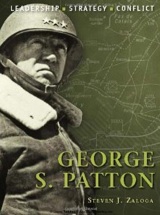George S. Patton: Leadership, Strategy, Conflict – Book Review
 George S. Patton: Leadership, Strategy, Conflict. Written by Steven J. Zaloga, Illustrated by Steve Noon. Osprey Publishing, 2010. 64 Pages, 15 Illustrations, 5 Maps. Softcover. $18.95.
George S. Patton: Leadership, Strategy, Conflict. Written by Steven J. Zaloga, Illustrated by Steve Noon. Osprey Publishing, 2010. 64 Pages, 15 Illustrations, 5 Maps. Softcover. $18.95.
Steven J. Zaloga has a tradition of producing finely-crafted pictorial histories. His latest book, George S. Patton: Leadership, Strategy, Conflict, is certainly no exception. At a concise 64 pages, the illustrated biography is what many of us have come to expect from Zaloga—a tightly written and copiously illustrated manuscript. In many ways, this has long been Zaloga’s strength as a historian. Through photographs and illustrations, he and his illustrators give us a dimension to the subjects that no amount of secondary prose could accomplish.
{default}Patton is not a groundbreaking piece of literature; neither is it a revisionist account intended to deconstruct or de-mythologize the man. Rather, it is a concise biography that highlights the career of one America’s most colorful combat leaders. The early years of Patton’s life are skimmed over within the first eight pages of the book. Immediately thereafter (despite a quick detour into the closing days of the North Africa campaign), the book focuses on Patton’s campaign of 1944–45 as the commander of the Third Army in Europe. This, of course, takes us through the Cobra breakout, the march to Seine, the relief of Bastogne, and finally, the push to the Rhine. Tables and charts depicting the corps-size units under Patton’s command are a useful addition to this part of the book.
Rather than succumbing to an “executive summary”—which befalls many other illustrated histories of comparable length—George S. Patton offers some great analytical tidbits. First, it discusses the command relationship between the Third Army and the XIX Tactical Air Group. Perhaps the most interesting section is the one that discusses Patton’s character and leadership style. In this section, the reader discovers that Patton was, in many ways, a tragic hero. It’s unfortunate that his colorful (and sometimes crude) personality overshadowed his remarkable wartime leadership. His relationship with Omar Bradley serves as an example: Whereas Patton was brash, cocky, and arrogant, Bradley was a highly-polished cavalier, reserved and mild-mannered. Their differences in personality shed light on why the post-war Army preferred the Bradley-style of leadership in its generals instead of the bombastic Patton-type.
As an officer, Patton had come of age during the First World War. As a pioneering member of the new Army Tank Corps, he saw many Allied generals content with a detached, managerial style of leadership which kept them far from the front lines, and thereby out of touch with conditions on the ground. Patton took this example to heart during his formative years as a field-grade officer—and strove not to emulate it when he was given his own wartime command. The “Life in Words” section is basically a “recommended reading” list of Patton literature. Interestingly enough, the 1970 film is featured prominently throughout this section.
In all, Patton contains as about much information as a reader can ask for within 64 pages. The book wasn’t intended to be an “in-depth” biography. But as a brief capsule of Patton’s career and leadership, the book accomplishes its task very well. Patton showcases what will continue to be a selling point for Zaloga’s work—concise and historically significant books that will attract readers who might otherwise be put off by the more lengthy and academic biographies.
Highly recommended.
Robert Helmsing is a freelance writer and military historian. A veteran of the U.S. Army, he is an avid scholar of guerrilla warfare and the history of World Wars I and II.


0 Comments
Trackbacks/Pingbacks